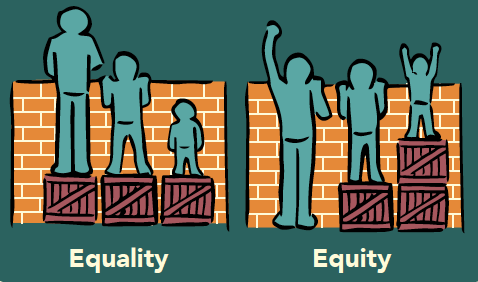The Wales Centre for Public Policy is currently contributing to the Welsh Government’s Gender Equality Review, announced by the First Minister earlier this year with the aim of making Wales a world leader in gender equality
Following our report in the summer on International Policy and Practice, we recently held a seminar for members of the Review’s advisory group and steering group, to help inform their decisions on what is meant by gender equality. Professor Emma Renold, Emma Taylor-Collins, Dr Rachel Minto, and Dr Alison Parken introduced the concepts of gender, intersectionality, and a feminist government, and led a discussion on what these could mean in a Welsh context.
Here are 5 things we learnt at the seminar:
- Gender Equality ≠ Gender Equity
Although these are related concepts and sound similar, gender equality and gender equity have different meanings and different usages. Gender equality means that people enjoy the same social, economic, and political rights, resources, opportunities, and protections regardless of their gender. Gender equity means fairness of treatment for each gender, according to their respective needs. This may mean that people receive equal treatment or different treatment considered equivalent in terms of rights, benefits, responsibilities, and opportunities. It ultimately means that gender equality is best achieved through gender equity.
 Image: Emma Renold / www.agenda.wales
Image: Emma Renold / www.agenda.wales
- Gender is how sexed bodies are lived, represented, and regulated
Gender is often misunderstood and sometimes confused or limited to related concepts, such as sex, gender identity, or gender expression. It is important to understand what gender is as it is a political concept that organises much of society.
The Welsh Government has chosen to define gender as how sexed bodies are lived, represented, and regulated. Gender is therefore a broad concept, encompassing gender as identity and as expression; gender in language and media; and gender in socio-cultural norms and in law. By thinking about gender being lived, represented, and regulated, we can explore how gender shapes, and is shaped by, economic, environmental, political, cultural, legal, historical, religious and spiritual factors.
- Intersectionality is more than just gender, race, and class
Intersectionality simply refers to the interaction between socially constructed categories and the resulting different levels of disadvantages resulting from these interactions. It originates in black feminist thought, as it was argued that the interests of black women were excluded from feminism and anti-racism. That is, we ought to look at how social divisions like gender, class, and race interact – or ‘intersect’ – with one another to produce particular experiences for particular groups.
Often, intersectionality has been dominated by the social categorisations of gender, race, and class. Whilst important categories, intersectionality is also about the interaction of other identity categories including disability, age, sexuality, faith, etc. It’s important to understand how all these aspects of identity interact with one another to show the systems of privilege and oppression at the macro-level.
- #metoo embodies the importance of intersectionality
Did you know that in 2006 Tarana Burke founded the Me Too Movement to support survivors of sexual violence, particularly Black women and girls, and other young women of colour from low wealth communities?
Tarana Burke’s Me Too Movement is different to #metoo, which went viral after Alyssa Milano’s tweet following the Harvey Weinstein revelations. Whilst both movements have similar aims, the different levels of public awareness of both movements show that the interaction of race and gender is important when considering how people experience advantage and disadvantage in society. Tarana Burke explains this in a recent interview: “The world responds to the vulnerability of white women. Our narrative has never been centred in mainstream media. Our stories don’t get told and as a result, it makes us feel not as valuable.”
- A feminist government is underpinned by principles, governance practices and institutions
Sweden is able to boast that it has the world’s ‘first feminist government’ because its principles, governance practices, and institutions underpin a commitment to gender equality. These principles include democracy, justice, and economic development, which whilst not exclusively feminist, are important for realising a feminist government. This is because they support Swedish governance practices of decision-making, resource allocation, and gender mainstreaming, and are supported through formal institutions (laws, rules) and informal institutions (norms and culture).
Next Steps
Following this event, the Gender Equality Review’s Advisory Group met to discuss what gender equality and a feminist government is in the Welsh context. These will inform the Gender Equality Review’s roadmap to advance gender equality in Wales, set to be released in July 2019.
The Wales Centre for Public Policy will also continue working on the Gender Equality Review over the coming months.